The physical neighbourhood environment may influence adults’ sedentary behaviour. Yet, most studies examining the association between the physical neighbourhood environment and sedentary behaviour rely on self-reported data of either the physical neighbourhood environment and/or sedentary behaviour. The aim of our most recent study was to investigate the associations between objectively measured physical environmental neighbourhood factors and accelerometer-determined total sedentary time in adults.
Read MoreMark your calendars .. we are hosting the 2019 International Ankle Symposium
Fresh out of this year's International Ankle Symposium, hosted by the Department of Exercise and Sport Science at UNC Chapel Hill, we are pleased to announce that the 8th edition will be held in Amsterdam. The year 2019 seems far away, but we have already started preparations to make you feel welcome.
Read MorePsychological care also key for professional rugby players
Awareness of the prevalence of symptoms of common mental disorders (CMD) should be improved in international rugby, and an interdisciplinary approach including psychological attention should be fostered in the medical care of professional rugby players. This is the main conclusion of a recent study to which we contributed.
Read MoreOnline tailored preventive advice for runners, not effective?!
Hot from the press and just published in the British Journal of Sports Medicine (online first), is our latest manuscript on prevention of running related injuries (RRIs) in Dutch trail-runners. This study evaluated the effectiveness of adding online tailored advice (TrailS6) to general advice on (1) the prevention of RRIs and (2) the determinants and actual preventive behaviour in Dutch trail runners.
Read More"Use your head, wear a helmet"; a nationwide campaign to increase helmet use in Dutch skiers and snowboarders
Head injuries are common in skiing and snowboarding with possible serious consequences, including long-term and serious disabilities, and death. Despite this knowledge and recommendations to wear a helmet, actual helmet use remains low. We developed and evaluated the effects of a nationwide campaign that focused on behavioural change as a key factor for its success to increase helmet use in Dutch skiers and snowboarders.
Read More




